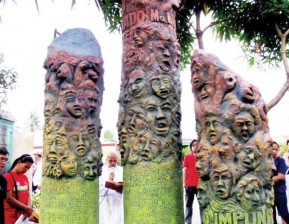
REMEMBERING 202 MISSING ACTIVISTS A concrete sculpture carved on three spear-shaped poles in Oton, Iloilo, bears the names of 202 activists abducted during the administration of former President and now Pampanga Rep. Gloria Macapagal-Arroyo. The poles stand on the spot where activists Maria Luisa Posa-Dominado and Nilo Arado were forcibly taken on April 12, 2007. PHOTO CONTRIBUTED BY THE SAVE LUISA AND NILO MOVEMENT
ILOILO CITY—Families and friends of missing activists have erected a concrete sculpture in Oton town in Iloilo where missing activists Maria Luisa Posa-Dominado and Nilo Arado were abducted five years ago.
The sculpture, consisting of three totems 2 to 3 meters tall with a diameter of 50 centimeters each, was unveiled on Aug. 31 to mark the International Day of the Disappeared, along the national highway in Barangay Cabanbanan in Oton town, about 7 kilometers from this city.
The site is where Dominado and Arado were waylaid and abducted by heavily armed men on April 12, 2007. They remain missing.
Their families and colleagues have blamed military agents for the abduction, pointing to the similarity with other cases in other places in the country, an allegation repeatedly denied by military officials.
Dominado was the regional spokesperson of Samahan ng mga Ex-Detainees Laban sa Detensyon at Aresto, an organization of former political detainees. Arado was chair of Bagong Alyansang Makabayan for Panay Island and leader of the farmers organization
Pamanggas.
Carved around the three spear-shaped poles are around 60 faces and the names of 202 missing activists.
“These depict the emotions of the victims and their families and at the same time the continued hope and struggle to find them and to be reunited with their families,” said Oton-based sculptor Gregorio “Boy” Masculino who was commissioned to conceptualize and carve the marker.
Seven others, mostly based in Oton, also helped in carving the marker. These were Jessie Tilos, Mark Nativo, Rey Buenaventura, Daryll Haro, Malou Buenaventura, Manny Haro and “Poker.”
The sculpture, which was completed in two weeks, was painted over in black, red, orange and yellow.
Louie Posa, Dominado’s brother and spokesperson of the Save Luisa and Nilo Movement, said the sculpture not only depicted the plight of his sister and Arado but also of the 202 victims of enforced disappearances under the administration of former President and now Pampanga Rep. Gloria Macapagal-Arroyo.
Posa said families, friends and colleagues of the missing activists raised funds to put up the markers.
But he said they had mixed feelings when it was unveiled.
“It’s a constant and painful reminder that our loved ones have not returned home and we still do not know if they will ever come back,” Posa told the Inquirer.
But he said the families believed that the marker also symbolizes the continued hope that they would be surfaced.
“This is not just about my sister and Nilo. This is for all the victims and their families who feel the same way that we do,” Posa said.